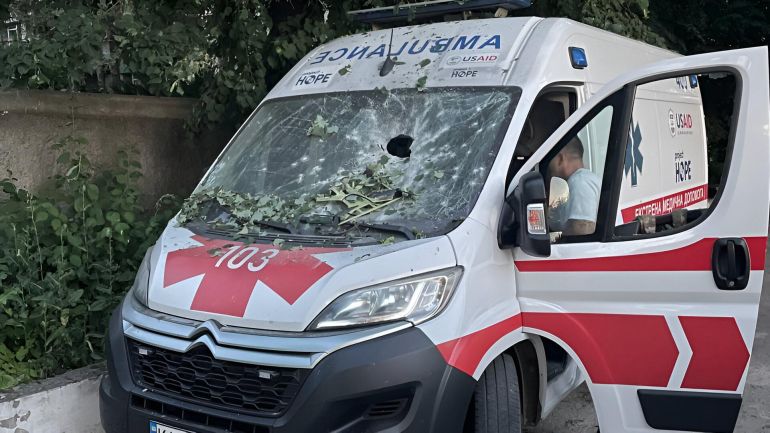Ukraine – Elina Dovzhenko, an emergency doctor, was far enough away from her car when a Russian drone struck it, causing the windshield to break and splatter pieces of shrapnel around.
Kupiansk, a bombed-out, nearly abandoned city, is less than 5 kilometers (3 miles) from the front line in Kharkiv, a northeastern Ukrainian region, and just 40 kilometers (25 miles) west of the Russian border on July 9 when it started to get dark.
However, there was still enough light for the Russian drone operator on the opposite side of the front line to recognize that Dovzhenko’s car was a white ambulance with red stripes parked close to a hospital where she and her colleagues were being attacked by shells.
Dovzhenko, 29, told Al Jazeera, “We heard the drone move, it swirled and swirled around the building, and then we heard the blast.”
She and her coworkers were shocked and angry but unsurprised. They have been regularly informed that Russian drones are attacking ambulances, rescue workers, and the people being rescued, primarily elderly people who had to leave their homes, pets, kitchen gardens, and family graves.
Every other day, they chase ambulances. They definitely targeted us, according to Dovzhenko’s ambulance partner, Denys Raievskyi, a 30-year-old paramedic.
According to the World Health Organization (WHO), their profession is among the riskiest in Ukrainian wartime. Since the start of the invasion in 2022, about 200 ambulances have been damaged or destroyed annually by Russian shelling attacks.
According to the statement, “Ambulance workers and other personnel providing health transport are three times more likely to die than other healthcare service workers.”
The Kremlin’s wider plan to systematically attack ambulances is intended to devastate Ukraine’s medical facilities and prevent millions of people from getting medical care, which causes their stress as well as physical and mental health issues.
According to the WHO, 46% of Ukrainians are concerned about their mental health, and 68 percent already report a decline in their health compared to the pre-war period.
The WHO reported that since 2022, it has verified 1, 682 attacks on Ukrainian healthcare facilities and workers, which have resulted in 128 deaths and 288 injuries for health professionals and their patients.
Children in the fire’s path
The number of attacks was described as “the highest number WHO has ever recorded in any humanitarian emergency globally,” according to a previous assessment from August.
In a statement released in July 2024, the Ukraine’s health ministry said, “These attacks are a deliberate crime against humanity aimed at destroying civilians and those who fight on the front lines for [their] lives.
The statement came in response to the July 8 strike that occurred in Okhmatdyd, Kiev’s largest children’s hospital, last year, in which eight children were hurt, and hundreds were hurt.
Russia launched an X-101 missile from 5, 500 kilometers (3, 420 miles) away, flying low to avoid detection and air defense, manoeuvres in mid-flight, and strikes its target with 10-meter (33ft) accuracy.
Moscow frequently denies that it intentionally attacks healthcare, claiming that it only attacks military installations and personnel.
International relief organizations claim to be aware of the severity of the situation and will continue to support Ukraine’s healthcare system.
Giorgio Trombatore, the regional director for Eastern Europe for Project Hope, an international humanitarian organization, stated to Al Jazeera, “Unfortunately, these types of situations are not new.” However, “We are resilient, and we will continue.”
The group operates 13 ambulances in four Ukrainian cities, five of which are in Kharkiv, including the one in Kupiansk, which was struck by a drone.
In recent months, drones have also been encountered by other ambulances, but neither ambulance received any injuries.
You can’t escape that, according to Trombatore, and you must be prepared for it eventually. “Thankfully, our team didn’t report any casualties,” the team said.
His organization also provides bulletproof ambulances and helmets, which help Russia combat its strategy of repeated strikes.
In one incident, a civilian was killed and another was hurt in a Sumy village on July 14 when a Russian drone attacked the area.
A second drone detonated two meters (7 feet) away from the vehicle when the ambulance team, supported by Project HOPE, arrived.
According to Project HOPE spokesman Artem Murach, “the car saved them because it was bulletproof.”

“Resistance and Hope”
Kupiansk, a city that once had a population of 22, 000, and sits on both banks of the slow, strategically-located Oskil river.
However, the mayor of Kharkiv, which was the de facto administrative center of the region’s Moscow-occupied region, surrendered the town days after the country’s first full-scale invasion began in 2022.
Six months later, during a daring counter-offensive against Ukraine, the Russians were forced to leave.
However, Russian drones, missiles, and artillery from Russia, which have killed dozens of civilians, injured hundreds, and damaged nearly every structure, remained within its reach.
In early 2023, when Russian forces started to attack again, the majority of the residents fled Kupiansk along with police, fire brigades, and government officials.
However, only about 1,200 people, or 7% of the pre-war population, perished.
They say, “I’d better die here, because it’s home, because they’re scared to leave, and they have no relatives to host them,” according to paramedic Raievskyi.
He lives with his wife in Saltivka, the second-largest city in Kharkiv, Ukraine’s second-largest city, about 120 kilometers (75 miles) east of Kupiansk, in the most shell-damaged region of Kharkiv.
Despite the almost constant shelling and omnipresent drones, Raievskyi’s ambulance travels for up to 1.5 hours to treat the sick and the injured.
However, he and his colleagues cannot treat their patients on the spot because another strike is always a possibility, especially if they have been injured by a drone.
Because Russians attach kilometers-long fibre-optic cables to their loitering munitions, a portable electronic jamming system that scrambles the drones’ navigation systems no longer function in the Kharkiv region.
Source: Aljazeera

Leave a Reply